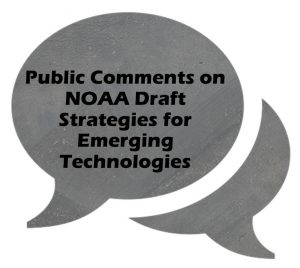Invitation to Comment on New NOAA Strategies to Apply Emerging Science and Technology
– NOVEMBER 27, 2019
The Gulf of Mexico Research Initiative’s science community is encouraged to participate in the NOAA Research Council’s efforts to expand the agency’s application of emerging science and technology and guide transformative advancements in NOAA science, products, and services.
The new draft NOAA strategies focus on Unmanned Systems, Artificial Intelligence, ‘Omics (genomics, transcriptomics, proteomics, and metabolomics), and the Cloud as these technologies are changing capabilities to observe, predict, and understand the environment.
The public comment period for the new NOAA strategies ends December 16, 2019.
You can access the announcement, download documents, and read how to submit comments at https://www.federalregister.gov/documents/2019/11/14/2019-24753/public-comment-for-the-four-draft-noaa-science-and-technology-strategies-noaa-unmanned-systems.
Summaries of the Four Draft Strategies
- Unmanned Systems Strategy: In recognition of the opportunities unmanned systems presents for addressing NOAA’s mission priorities, the NOAA Unmanned Systems Strategy provides a framework to: (1) efficiently provide requirements-driven, safe, cost-effective, and compliant Unmanned Systems services across the agency; (2) prioritize strategic investments in Unmanned Systems applications and technologies that fuel innovation and strengthen operations, and (3) accelerate and enhance capabilities through partnerships.
- Artificial Intelligence Strategy: The overarching goal of the NOAA Artificial Intelligence (AI) Strategy is to utilize AI to advance NOAA’s requirements-driven mission priorities. Through this strategy, NOAA seeks to reduce the cost of data processing, and provide higher quality and more timely scientific products and services for societal benefits.
- ‘Omics Strategy: In recognition of the opportunities and challenges presented by the advent of ‘omics tools, the NOAA ‘Omics Strategy provides a framework to advance the application of ‘omics to address mission priorities. The strategy leverages NOAA’s current organizational structure to more effectively implement ‘omics through improvements in computational and analytical capacities, targeted research, technology transition, workforce proficiency, and partnerships across NOAA’s lines, federal agencies, and extramural research and commercial communities.
- Cloud Strategy: NOAA’s robust experience with cloud applications is already beginning to demonstrate significant improvements in performance and skill in areas such as satellite data products and services, numerical weather prediction, ocean models, and big data analysis, storage and dissemination. Cloud services will be further leveraged to expand benefits, such as: (1) accelerated timeline to acquire new computing resources, (2) increased security posture, (3) more accessible and monetizable NOAA data to customers, such as academia and industry, (4) reduced transition time from research to operations, (5) scalable infrastructure that supports scientific and high performance computing requirements, and (6) a more agile and innovative culture.
By Nilde Maggie Dannreuther. Contact maggied@ngi.msstate.edu with questions or comments.
************
The Gulf of Mexico Research Initiative (GoMRI) is a 10-year independent research program established to study the effect, and the potential associated impact, of hydrocarbon releases on the environment and public health, as well as to develop improved spill mitigation, oil detection, characterization and remediation technologies. An independent and academic 20-member Research Board makes the funding and research direction decisions to ensure the intellectual quality, effectiveness and academic independence of the GoMRI research. All research data, findings and publications will be made publicly available. The program was established through a $500 million financial commitment from BP. For more information, visit https://gulfresearchinitiative.org/.
© Copyright 2010-2019 Gulf of Mexico Research Initiative (GoMRI) – All Rights Reserved. Redistribution is encouraged with acknowledgement to the Gulf of Mexico Research Initiative (GoMRI). Please credit images and/or videos as done in each article. Questions? Contact web-content editor Nilde “Maggie” Dannreuther, Northern Gulf Institute, Mississippi State University (maggied@ngi.msstate.edu).






